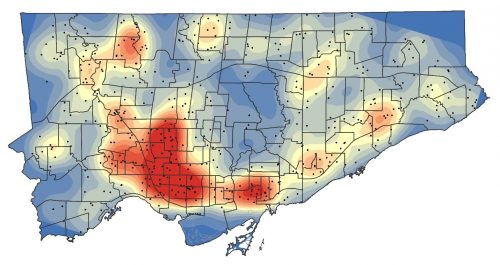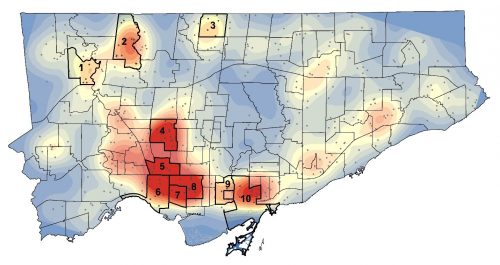
In the past five years (2017-2021), 59 per cent of fires with loss in residential homes in the City of Toronto did not have a working smoke alarm present. There are more than 437,000 residential homes (detached, attached or semi-detached) in the city.
With the intention of developing a focused fire safety education campaign to address this issue, Toronto Fire Services conducted a comprehensive risk analysis to identify areas most at risk of having a home fire with loss. A risk ranking methodology was used based on the degree of likelihood and severity of harm that can result from a structure fire in residential homes. Geographical Information System (GIS) was used to rank areas of the city against the relative risk.
On Wednesday, December 21, Toronto Fire Services is launching a campaign to directly impact behaviour change around smoke alarm functionality in these areas, which can then be monitored and evaluated for future assessments.
The figure below illustrates the areas of concentration where fires with loss have occurred in single-family homes.
Figure 1: Fires with Loss in Residential Homes (with neighbourhood boundaries)

The areas of concentration seen in the south end of the city are older neighbourhoods where the density of homes is highest. The areas in the south include:
There are also three smaller pockets in the north end which experienced high concentration of fires with loss. These areas in the north include:
The top ten neighbourhood areas were identified based on a relative degree of likelihood and severity of harm that could result from a fire hazard.
Figure 2: Illustration of the Top 10 Neighbourhood Focus Areas

Table 1: Neighbourhoods in Scope Details
| Label | Area | Neighbourhood | Station |
| 1 | Rexdale | Rexdale-Kipling | 415 |
| Elms-Old Rexdale | |||
| 2 | Black Creek / Glenfield-Jane Heights | Glenfield-Jane Heights | 142 |
| Black Creek | |||
| 3 | Newtonbrook West | Newtonbrook West | 112 |
| 4 | Briar Hill / Caledonia / Oakwood | Briar Hill-Belgravia | 341 |
| Caledonia-Fairbank | |||
| Oakwood Village | |||
| 5 | Junction / Dovercourt | Junction-Wallace Emerson | 345 |
| Dovercourt Village | |||
| 6 | Parkdale / Roncesvalles / Little Portugal | Dufferin Grove | 426 |
| Roncesvalles | |||
| Little Portugal | |||
| South Parkdale | |||
| 7 | Trinity-Bellwoods / West Queen West | Trinity-Bellwoods | 331 |
| West Queen West | |||
| 8 | Little Italy/ Kensington | Palmerston-Little Italy | 315 |
| University | |||
| Kensington-Chinatown | |||
| 9 | Moss Park / Cabbagetown | Moss Park | 325 |
| Cabbagetown-South St. James Town | |||
| 10 | Riverdale | North Riverdale | 324 |
| South Riverdale |
Further analysis looked at the top five ignition sources for residential homes. The top two ignition sources identified were related to cooking and smoking.
Table 2: Top Five Ignition Sources Residential Home Fires with Loss
| Ignition Source | Focus Areas | City-Wide |
| Cooking equipment | 29% | 31% |
| Open flame tools, smokers’ articles | 25% | 19% |
| Electrical distribute equipment | 12% | 14% |
| Appliances | 12% | 8% |
| Heating equipment | 8% | 9% |
Data Source: TFS RMS, Fire Incidents (01 Fires, 02 Explosions) excluding Arson with Est. Loss > $5 or Civilian Injury, Weighted by indicators of harm (Injury, Fatality, Fire Spread, Exposures), 2017 to 2021
More information on smoke alarms and the new smoke alarm campaign is available on the Safety Tips & Prevention webpage. The webpage also has a link for residents and businesses to embed dates in a phone/computer as a reminder to change smoke alarm batteries.
Toronto is home to more than 2.9 million people whose diversity and experiences make this great city Canada’s leading economic engine and one of the world’s most diverse and livable cities. As the fourth largest city in North America, Toronto is a global leader in technology, finance, film, music, culture and innovation, and consistently places at the top of international rankings due to investments championed by its government, residents and businesses. For more information visit the City’s website or follow us on Twitter, Instagram or Facebook.